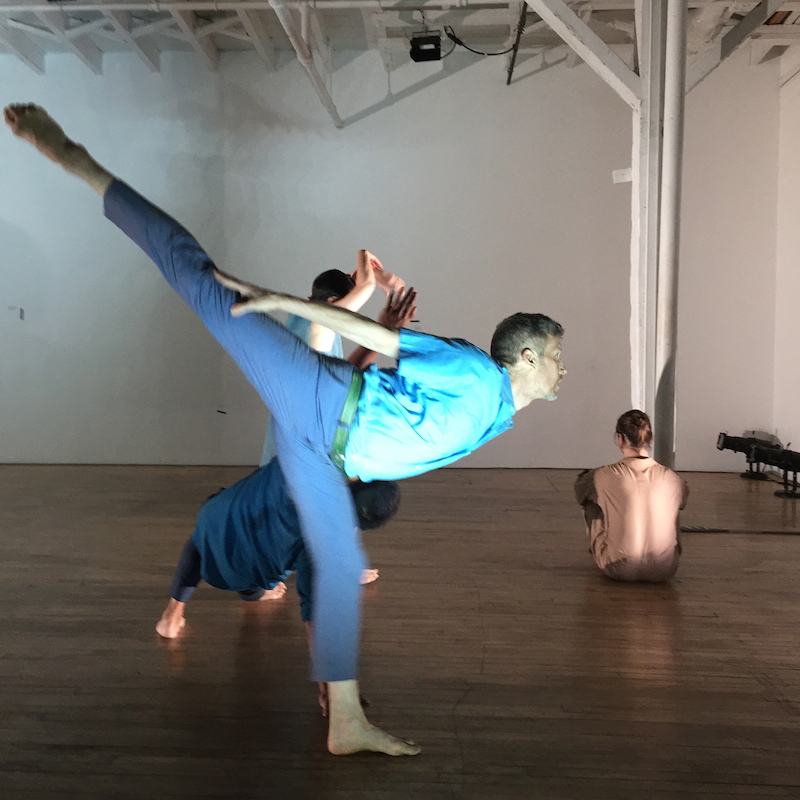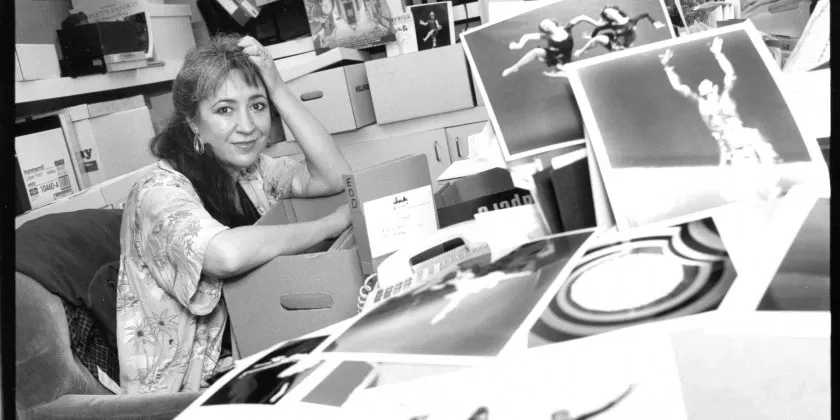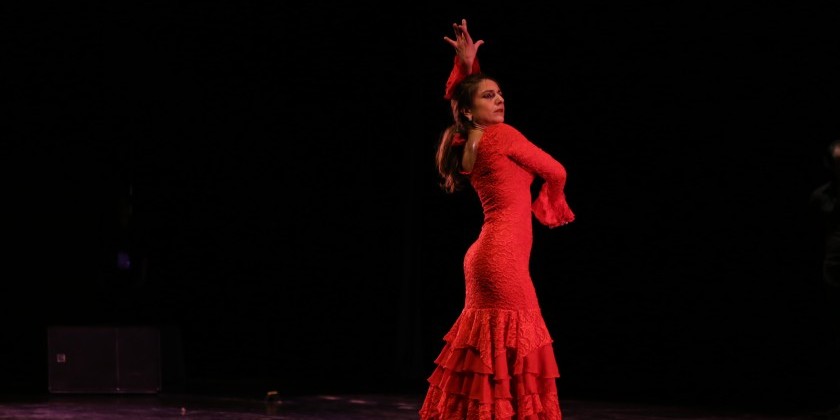The Dance Enthusiast Asks: Rebecca Stenn about RIPARIUS (Belonging To The River), Life, and Success

RIPARIUS (BELONGING TO THE RIVER)
(A collaborative evening-length work, the second in a three-part series)
Upcoming Performances Thursday June 18-20, 2015 at the Gowanus Loft 61 9th Street Brooklyn-- For Tickets Go To Eventbrite
Choreography and performance: Rebecca Stenn, Eric Jackson Bradley, John Mario Sevilla, Bri White
Music: Jay Weissman, Nine Inch Nails, John Cage, Irate, Kill the Noise, Benoit Pioulard
Projection Design: George Del Barrio /Sound Design: Jay Weissman/ Lighting: Kathy Kaufmann
Costume: Emma Hoette with Eric Jackson Bradley
As we set off into summer, I thought it might be worthy to experiment with a different approach to sharing thoughts on an evening of dance work. Why not include a discussion with the choreographer of said evening? In this case, I am speaking with Rebecca Stenn, whose work RIPARIUS I saw on Thursday the 8th of June. RIPARIUS will be performed again from the 18th- 20th of June.
Christine Jowers for TDE: How do you think the show went on opening night?
Rebecca Stenn: We were really very happy with it. You know, it is a complicated piece with a lot of layers and everything felt like finally it came together—the choreography, the space, the projections, the ability of the dancers to have our rhythm and timing, the music. We felt like we managed to have a rhythm on that night and that was exciting.
TDE: Has the work changed since opening night. I know you have not completed your run, but so far?
RS: We’ve had three shows so far. And we are all committed to the idea of never having the same show twice. That has been important. We talk about it when we are standing in the wings about to go on—All four of us (dancers), as well as our tech team for the light and sound, so all seven of us, are committed to letting it not have to be like last night, do you know what I mean? Not to hold on really tight to how it was.
TDE: I noticed the dancers spoke to one another in gesture and sculptural form —each of you with your own motifs.
You, for example, gathering the air with your arms as if wanting to bring it inside you. John Mario Sevilla, with slightly bent legs, favoring a backward circular walk on the balls of his feet, and then Eric Jackson Bradley repeating a movement in which he caresses his knee sending his leg into a backward extension. I also noticed Eric’s constant leaning and momentary balances on the backs or sides of the other dancers. I appreciated your gestures, their repetition, and how the very same movement changed mood within each section of the your piece.
RIPARIUS, put me in the mind of water, and as I watched all of you I imagined looking at the rain, seeing droplets of water fall on a hard surface. It is fascinating to see what drop (dancer) goes where, and to notice that each little drop or rivulet has particular motion. Will the water drops rush in response to the magnetism of another body of water, or will they remain absolutely still, like Bri White, who sits with his back to us for quite awhile at the beginning of your piece? Your responses to one another held my interest. Your relationships changed from an assured independence and interest in abstract design to more labored situations with mood shifts. I noticed you became more reliant one another as the piece evolved. All of the sudden I saw people going on a journey and I thought, "Well that is different from where I thought this piece was going to go."

RS: I was interested in trying to talk about capriciousness, the fact of not knowing. You just don’t know which way the rivulet will go, the curve and the speed… It starts off quite architecturally, our relationships within the movement, then it goes in a progression hopefully that doesn’t bang you over the head, but becomes much more human and less architectural— even though we are playing with the same movement throughout.
TDE: What about the other elements? The sound created by Jay Weissman? The video by George Del Barrio? Do you have much input or control of those elements or do you let Jay and George create what feels right to them?
RS: We (George/Rebecca) both believe that the video and the dance piece support one another and there shouldn’t be a situation where you are confused about what to watch unless we want it to be that way. In our first iteration, the 40 minute solo, TIME I KNOW (RIPARIUS is the second part of a series of three) very rarely did we have the video interact with the dancer. This time we thought it might be interesting to have the audience make the choice about what to watch. That was very considered. We consider the audience sophisticated and smart and we wanted to give them those kind of challenges. And then George, I trust him. I told him I like architectural images and at the end I would like something elemental like water: he took that and ran with it. I found the music tracks just through hours of listening. I wanted them to be representative of the idea of not knowing what was going to happen next. I got a kick out of really horrid heavy metal following something that was very beautiful. I got a kick out of the huge swings. Then, Jay who does sound design and played over stuff, really acts as a sort of a connective tissue.
TDE: I was wondering what was happening as the music was getting more clubby. I was confused. “I don’t know where she is going.”
RS: Yes, the capricious nature of life. You don’t know where you are going or what is going to happen next. And look, frankly, like all of us do, we make dances based a little bit on our lives. My life this year has been about accepting that things can be crazy, and this was my attempt at saying, “Yeah, aha, nobody knows. I am just going to slam you into this heavy metal track because you just don’t know when that ( slamming) is going to happen.”
TDE: I know that you have been going through a lot this year. You found out your husband, and your collaborator, Jay Weissman, has colon cancer. Is it alright if I mention that in this piece?
RS: Jay is doing chemotherapy for colon cancer-- what a trouper…I feel guilty asking him to work but he says, “No, no, this is what I need, I need to be engaged.” And then he is not thinking about how crappy he feels, but about the work. Jay and I are one-hundred percent transparent. We are not the only people to go through this. It is not a big secret, it’s life, and this happens. Maybe somebody, somehow can get inspired to deal with this through Jay.
TDE:There was something redemptive about your piece ( perhaps because of all you have been dealing with in your life outside choreography) it felt as if by the end, that you acknowledged despite everything, we are all part of a flow --lifes journey.
TDE: How do you feel about your career at this point Rebecca? You danced with Momix for 9 years, created your own company in 1996, have danced all over the world, choreographed for opera, TV and even the Rockettes? Do you enjoy it more now, are you satisfied and do you feel successful?
RS: I started to think about the place I am in now as opposed to when I did my first show 20 years ago in 1995. I enjoy it so much more than I used to. I am connected to my dancers in a way I never was before. I am a mother, and a wife, and a teacher, and I am grateful to have the opportunity to perform at all—utterly lucky. It is amazing that I am still able, and I have a healthy body. You come to a place where you go, this is what I do, this is my work, it is me. I am confident in it. I don’t want to sound like I don’t have doubts— I have doubts all the time —but basically I am not trying to look like somebody else, or dance like somebody else, or define a genre . I am more settled and that takes a long time. Regarding your question about success, if you are able to express yourself as an artist in a way that feels right, you are successful. I walk into that loft with these dancers and people come and like it. That’s a success. I am not looking for too much more.
Share Your Audience Review. Your Words Are Valuable to Dance.
Are you going to see this show, or have you seen it? Share "your" review here on The Dance Enthusiast. Your words are valuable. They help artists, educate audiences, and support the dance field in general. There is no need to be a professional critic. Just click through to our Audience Review Section and you will have the option to write free-form, or answer our helpful Enthusiast Review Questionnaire, or if you feel creative, even write a haiku review. So join the conversation.














